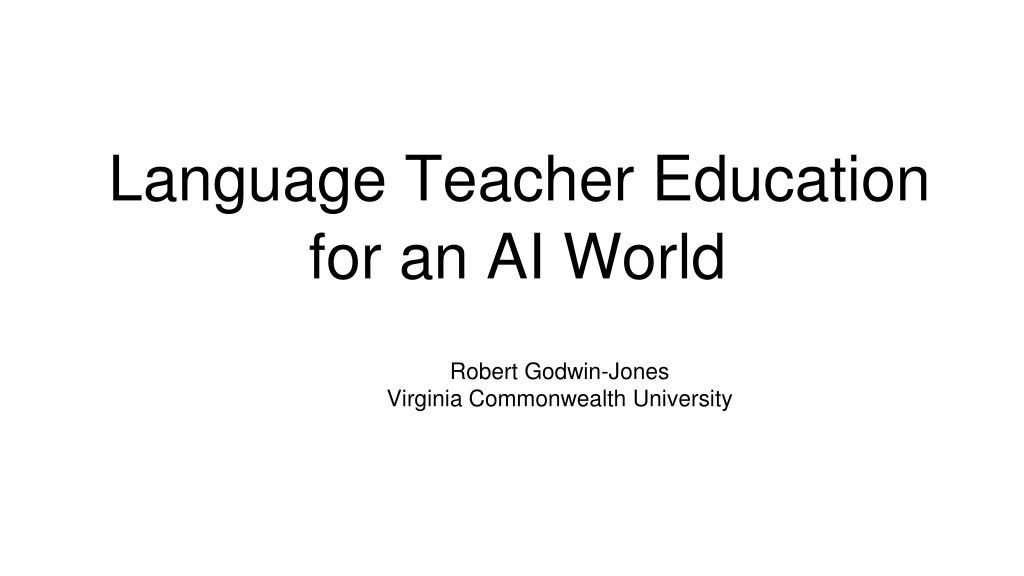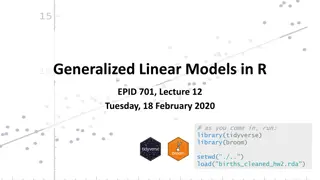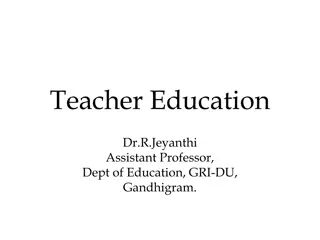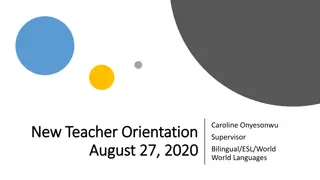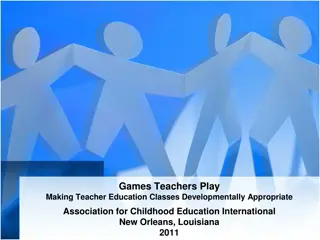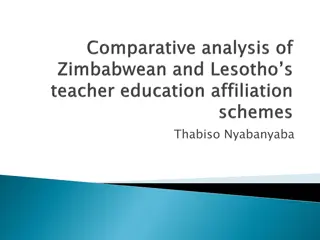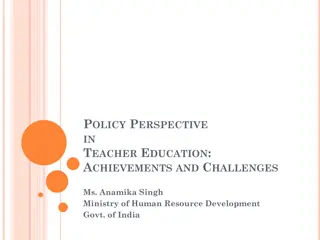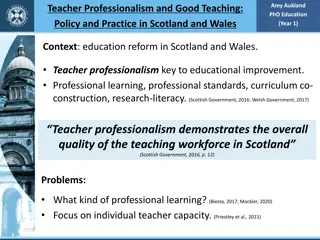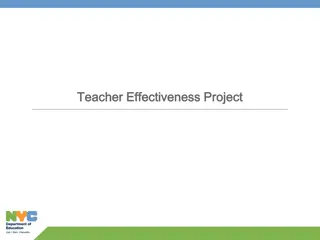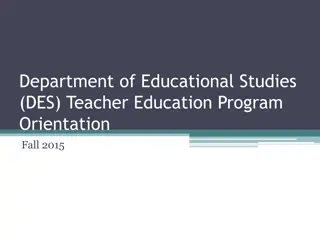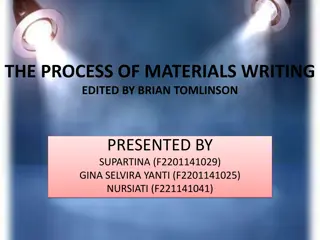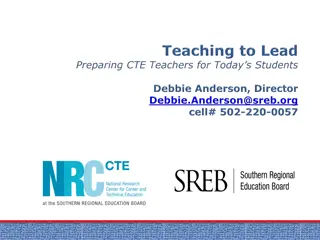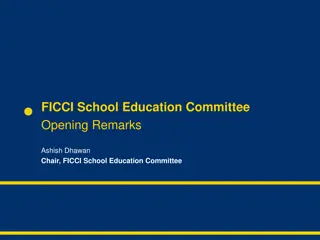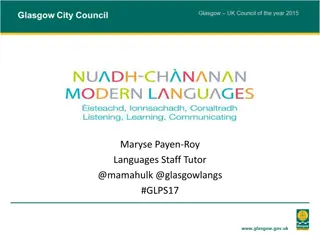Language Teacher Education in the Age of AI: Navigating Tools and Challenges
Underlying the evolving landscape of AI in language education, this publication explores the critical need for language teachers to grasp AI tools' functioning and limitations. The emergence of generative AI, exemplified by ChatGPT, presents both opportunities and concerns in educational contexts. Educators must cultivate critical AI literacy to guide informed use of these tools while acknowledging the complexities of AI systems. A nuanced understanding of generative AI is crucial to integrating smart technologies effectively into language curricula.
Download Presentation

Please find below an Image/Link to download the presentation.
The content on the website is provided AS IS for your information and personal use only. It may not be sold, licensed, or shared on other websites without obtaining consent from the author. Download presentation by click this link. If you encounter any issues during the download, it is possible that the publisher has removed the file from their server.
E N D
Presentation Transcript
Language Teacher Education for an AI World Robert Godwin-Jones Virginia Commonwealth University
Underlying assumptions AI language tools here to stay and will improve; usage likely ubiquitous Language teachers will need an understanding of how tools work & limitations Teachers will use that knowledge to discuss/demonstrate informed use AI not a silver bullet: need to find ways to integrate smart tools into curriculum - Carvalho L. et al.. (2022). How can we design for learning in an AI world?, Computers and Education: Artificial Intelligence, 3, 1 9. https://doi.org/10.1016/j.caeai.2022.100053. - McMurtrie, B. (2023, Jan. 5), Will ChatGPT Change the Way You Teach? The Chronicle. Link - Otsuki, G. J. (2020, January 23). OK computer: to prevent students cheating with AI text-generators, we should bring them into the classroom. The Conversation. Link
The new face of AI Release of ChatGPT a year ago: first publicly available generative AI tool Capabilities that transfixed users: speed, quality, versatility, memory, redos AI itself not new: ranking algorithms, machine translation, voice, predictive text But generative AI has created an AI frenzy: images, voice, video => businesses Also a lot of concerns, ethical, social and practical => many different reactions
The nature of generative AI Differing assessments of generative AI due to uncertainty and unpredictability AI systems different from traditional computer coding => largely a black box Early AI: teach machines how to speak/think like humans => learn syntax, etc. LLM: Generates language based on statistical modeling/machine learning No real understanding of language/human society, just extrapolating from data Model of language that emerges = usage-based, i.e. constructions over rules - Wingard, J. (2023, Jan. 10). ChatGPT: A Threat To Higher Education? Forbes. Link - Wolfram, S. (2023, Feb. 14). What Is ChatGPT Doing ... and Why Does It Work? Link - Multiple talks at AsiaCALL 2023 [and at many other conferences! Most focused on ChatGPT]
Developing critical AI literacy Need for teachers and students to become informed consumers Develop calibrated trust in AI: understand pluses and limitations (Ranalli, No real human-like intelligence => very sophisticated data mining No real understanding of human language or of human social world Inaccuracies and hallucinations / WEIRD cultural bias (Altari et al., 2023) - Atari, M., Xue, M.J., Park, P.S., Blasi, D. and Henrich, J., 2023. Which Humans?.PsyArXiv Preprints. https://psyarxiv.com/5b26t/ - Ranalli, J. (2021). L2 student engagement with automated feedback on writing: Potential for learning and issues of trust. Journal of Second Language Writing, 52
Narrow AI: AI writing tools from AWE to Grammarly Automated writing evaluation: from essay marking to writing assistant Not designed for L2 learners; institutional tool; AWE values language mechanics More widely used: enhanced grammar checkers like Grammarly; synchronous CF As do other writing tools, integrates AI-based auto-completion and more Widely used; studies show useful for proofing, rather than writing development - Recent special issue of Language Learning & Technology on AWE / Emerging tech column: Partnering with AI - Ranalli, J. (2021). L2 student engagement with automated feedback on writing: Potential for learning and issues of trust. Journal of Second Language Writing, 52, 100816. https://doi.org/10.1016/j.jslw.2021.100816 - O Neill, R., & Russell, A. M. (2020). Grammarly: Help or hindrance?. Journal of Academic Language and Learning, 13(1), A88 A107. https://journal.aall.org.au/index.php/jall/article/view/591
Machine translation Also widely used, especially Google Translate in mobile devices Use in instructed SLA has been controversial; cheating ; end of FL instruction Recent studies show not primarily wholesale copy & paste Important to discuss with students how best to use machine translation and other AI tools Creative uses in drafts, critical analyses, comparisons; exploring multilingualism - Recent special issue in L2 Journal - Hellmich, E., & Vinall, K. (2021). FL instructor beliefs about machine translation: ecological insights to guide research and practice. IJCALLT, 11(4), 1 18. Link - O Neill, E. M. (2019). Training students to use online translators and dictionaries: The impact on second language writing scores. International Journal of Research Studies in Language Learning, 8(2), 47 65. https://doi.org/10.5861/ijrsll.2019.4002 - Vinall, K., & Hellmich, E. A. (2021). Down the rabbit hole: Machine translation, metaphor, and instructor identity and agency. Second Language Research & Practice, 2(1), 99 118.http://hdl.handle.net/10125/69860
Instructional use Studies in machine translation use instructive for AI in language learning AI use shown to be equally varied => not whole cloth assignment completion Example of Chinese student writing in English in Jacob et al. (2023) Used AI for: brainstorming, parts of 1stdraft, revising, but kept own voice/style Prompt engineering => iterative, chain-of-thought approach - Jacob, S., Tate, T., & Warschauer, M. (2023). Emergent AI-Assisted Discourse: Case Study of a Second Language Writer Authoring with ChatGPT. arXiv preprint arXiv:2310.10903
AI Chatbots Not just writing tools; for language learning as backend in chatbots Conventional chatbots: scripted, but tailored to language learning Potential of personalized tutor/companion based on individual interactions => VR Lessons from studies in informal language learning => incidental SLA Sockett, G.
ChatGPT and the Future Many concerns: privacy, reliability/appropriateness, cost, social justice AI may lead to a reconsideration of the goals of language education generally Linguistic accuracy no longer a synonym of learning and excellence (p. 107) Given AI capabilities, we might emphasize pragmatic/cultural aspects of language Integrate AI tools into broader writing program of authentic communication (VE) - Godwin-Jones, R. (2019) In a World of SMART Technology, Why Learn Another Language? Ed Tech & Society - Klekovkina, V., & Deni -Higney, L. (2022). Machine translation: Friend or foe in the language classroom?. L2 Journal, 14(1), 105 135. https://doi.org/10.5070/l214151723
Q & A Thank you! Questions/comments?
